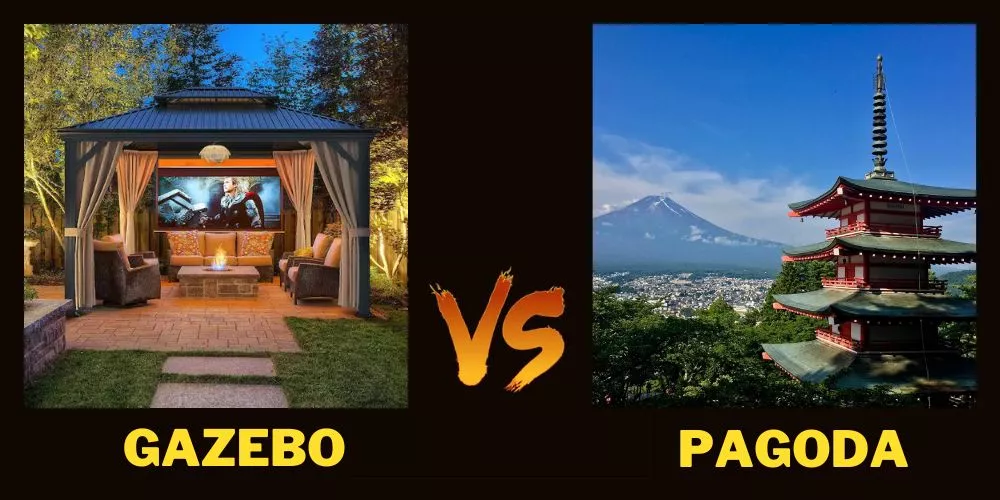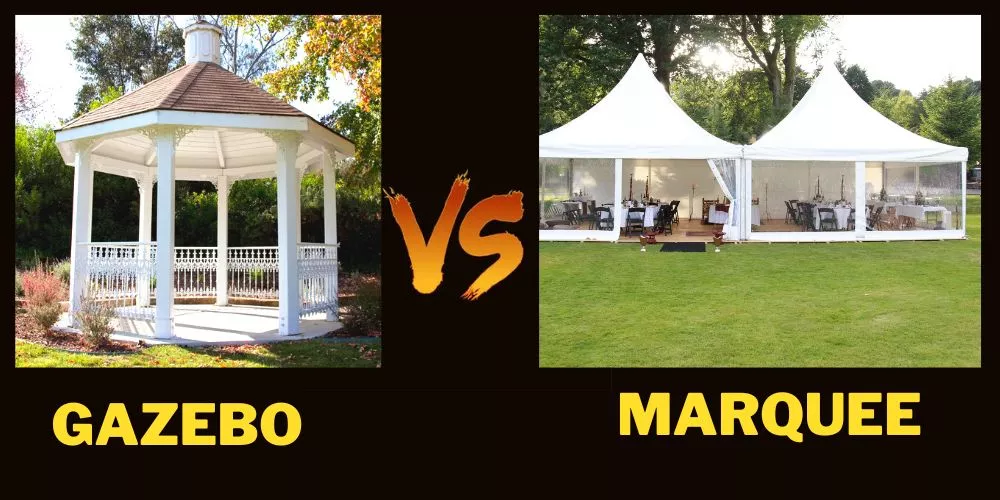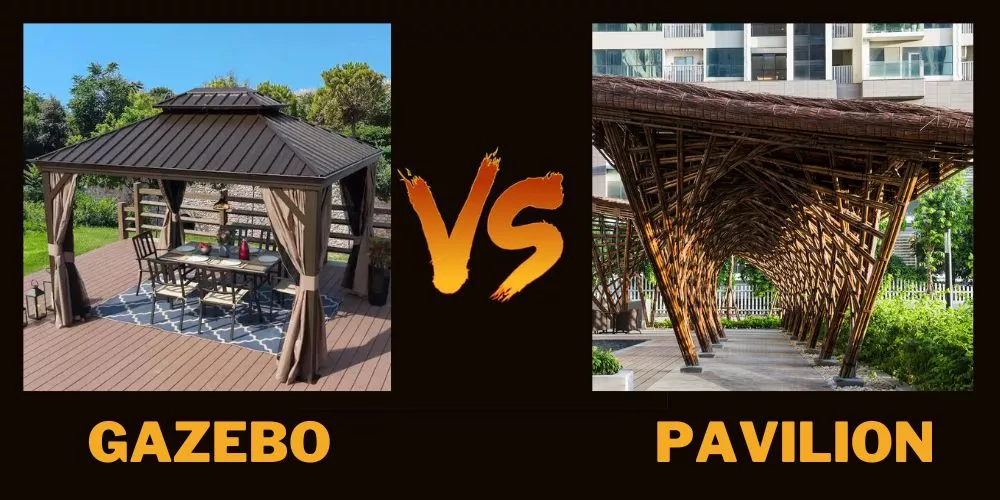Stepping into a backyard or strolling through a serene garden, you’ve likely encountered two iconic structures that capture the attention: gazebos and pagodas. While both offer shelter and beauty, their roots stretch deep into different historical and cultural soils. With their open designs, Gazebos have charmed Western landscapes for centuries, while pagodas, with their tiered roofs, tell tales of ancient Asian traditions.
You’re in the right place if you’ve ever felt overwhelmed or uncertain about these architectural marvels. This article dives deep into their distinct features, historical significance, and modern adaptability, guiding you toward an informed choice for your space. Let’s look at gazebo vs pagoda comparison in details.

Gazebo vs Pagoda: A Comparative Analysis
Through a side-by-side comparison, I will delve into the aesthetics, cultural roots, functionalities, and intricacies of each, shedding light on their unique attributes and shared traits. Join us as we embark on this comparative journey, enabling you to decide on your next architectural endeavor.

1. Aesthetic Appeal and Purpose
The allure of any architectural structure often stems from its visual magnetism and the purpose it serves.
Gazebo’s Decorative and Open Design
The gazebo stands as a testament to openness and aesthetic freedom. Its open sides and typically octagonal shape invites a seamless blend of nature and man-made elegance. It’s a space where light flirts with shadows, creating a dynamic play that enchants occupants. The gazebo isn’t just a structure; it’s an experience, designed to be decorative while providing a vantage point to relish surrounding beauty.
Pagoda’s Serene and Layered Architecture
Conversely, the pagoda speaks volumes through its silence and layered grandeur. Traditionally multi-tiered with gracefully curving roofs, it exudes serenity and depth. The cascading layers draw the eyes upward, symbolic of a spiritual ascent. It’s more than an architectural piece; it’s a meditative realm, reflecting peace, introspection, and profound cultural nuances.
2. Cultural Context
The roots of a structure provide insight into its essence and the tales it might tell.
Gazebo’s Predominantly Western Origins
Emerging from the gardens of Renaissance Europe, gazebos have been cherished as a haven for relaxation and social gatherings. They’re intrinsically linked to Western ideals of leisure and the appreciation of nature, acting as a bridge between the indoors and the vast expanses of the outdoors. They encapsulate a Western fondness for open-air interactions, whether casual tea or a grand outdoor ball.
Pagoda’s Asian and Buddhist Roots
Contrastingly, the pagoda is a sentinel of Asian history and spirituality. Originating from the Indian stupa and evolving across East Asia, the pagoda is deeply entwined with Buddhist teachings and practices. Its very design — ascending layers, often crowned by a finial resembling a flame — symbolizes enlightenment. In its quiet majesty, the pagoda resonates with tales of ancient rituals, spiritual quests, and the rich tapestry of Asian civilization.
3. Usage Scenarios
Every structure tells a story of its purpose, echoing the sounds, silences, and activities designed to host.
Gazebos for Social Gatherings and Events
Imagine a summer’s evening, the soft chirping of crickets, laughter in the air, and a gentle breeze rustling the leaves. This is the ambiance a gazebo cultivates — a hub for social interactions. Perfect for garden parties, wedding ceremonies, or simply a family barbecue, gazebos offer a versatile space that integrates nature into every event, making moments memorable.
Pagodas for Meditation and Spiritual Practices
Where gazebos buzz with chatter and merriment, pagodas offer a sanctuary of silence. Their very design promotes introspection. Walking into a pagoda, one can’t help but feel a shift towards a more contemplative, spiritual state. Pagodas are often found in temple complexes as focal points for meditation, spiritual teachings, and rituals, beckoning seekers to find tranquility within their shade.
4. Construction and Complexity
The construction methodologies of these structures mirror their cultural backgrounds and intended purposes.
Gazebo’s Straightforward Construction
Building a gazebo often follows a more direct approach. Its foundational design remains consistent with standard materials like wood, metal, or vinyl: a raised floor, pillars for support, and a roof. The open sides facilitate ventilation and panoramic views, and while customization can add complexity, the core structure remains accessible for even amateur builders.
Pagoda’s Intricate Tiered Design
Crafting a pagoda is an art form steeped in tradition. Each tier, with its gracefully arching eaves, requires meticulous attention. Often made of wood or stone, these structures demand precision, ensuring stability despite their height. Their multi-layered design isn’t just for aesthetics; it’s a reflection of spiritual ascension, making their construction both a technical and symbolic endeavor.
What is a Gazebo? (Elegance and Versatility)
What exactly makes a gazebo, a gazebo? Before we delve into the finer details, let’s understand the essence of this beloved architectural feature.

Definition and Features
In its simplest form, a gazebo is a freestanding, pavilion-like structure, often hexagonal or octagonal in shape, designed primarily for relaxation and leisurely activities. Its origins can be traced back to ancient civilizations, evolving to adapt to various cultures and needs.
Materials
Gazebos are crafted from diverse materials, each adding a unique touch to the structure. Traditional gazebos are often made of wood, such as cedar or redwood, providing a rustic charm and promising durability. Metal gazebos, typically constructed from wrought iron or steel, offer a more modern or Victorian touch. For those seeking longevity with minimal upkeep, vinyl becomes a popular choice, ensuring resistance to wear and tear.
Roof Styles
The roof of a gazebo is not just about shelter; it’s a statement of style. Open roofs let you gaze at the stars, single-tiered roofs offer a simple, elegant cover. In contrast, double-tiered roofs exude grandeur, providing extra ventilation and often featuring a decorative top.
Open Sides
Perhaps one of the most distinguishing features of a gazebo is its open sides. This design facilitates a 360-degree view of the surroundings and ensures a seamless integration with nature, allowing inhabitants to feel the breeze, hear the rustling leaves, and immerse themselves in the environment.
Functionality and Usage
With their aesthetic appeal, Gazebos have found a place in various settings, both personal and commercial.
Residential Applications
Many homeowners find gazebos an enticing addition to their spaces. Whether in the backyard as a tranquil reading spot, by the garden providing a bird’s-eye view of blooming flowers, or poolside offering shade after a refreshing swim, gazebos elevate the residential experience.
Recreational Uses
Their inherent charm makes gazebos an ideal choice for outdoor events. Picture a gazebo adorned with fairy lights hosting a wedding ceremony or draped in vibrant fabrics for a birthday bash. From intimate gatherings to large parties, gazebos set the stage for memorable moments.
Commercial Applications
Beyond personal spaces, gazebos grace various commercial venues. Parks often house gazebos as resting points, offering visitors a place to pause and soak in the view. Hotels and resorts, too, employ gazebos to enhance their landscape, providing guests with cozy nooks to relax or dine in.
Design and Customization
At the heart of a gazebo’s appeal lies its adaptability. Each gazebo can be a blank canvas, reflecting its owner’s or designer’s personal touch and creativity.
Shapes and Sizes
While the classic gazebo might conjure images of an octagonal beauty, there’s a world of shapes to explore. From squares and rectangles to more complex dodecagons, the gazebo’s structure can be chosen to fit the available space and desired aesthetic. Whether it’s a petite installation for intimate gatherings or a sprawling structure for grand celebrations, there’s a gazebo for every need.
Ornamental Elements
The artistry of a gazebo often lies in its details. Railings can range from simple wooden balusters to intricate wrought-iron designs. Lattice work, commonly seen on the gazebo’s sides, lends a delicate charm while also offering a smidgen of privacy. Benches, built-in or standalone, ensure the gazebo is always ready to host weary souls seeking respite.
Customization Options
Once the foundational design is set, the real fun begins! Gazebos can be painted or stained to resonate with the surroundings or stand out as a statement piece. Staining can enhance and preserve the natural beauty of wooden gazebos. And as the sun sets, lighting options like string lights, chandeliers, or solar lanterns can transform a gazebo into a magical haven.
Pros and Cons
Like any structure, gazebos come with their set of advantages and considerations.
Advantages
✅ Shelter: One of the primary purposes of a gazebo is to provide shelter, be it from the blazing sun, a sudden drizzle, or even a snowflake.
✅ Aesthetic Appeal: With their unique designs and customizable features, gazebos are a visual treat, enhancing the beauty of any space they occupy.
✅ Versatile Usage: From a quiet meditation spot to a bustling party venue, the gazebo’s multifunctional nature is one of its strongest suits.
Disadvantages
❌ Cost: A well-constructed gazebo can be an investment, with costs rising based on materials and customization.
❌ Maintenance: While built to last, gazebos, especially wooden ones, require regular maintenance to ward off wear and tear.
❌ Susceptibility to Weather: Extreme weather conditions, such as heavy snowfall or strong winds, can pose challenges, making it essential to consider the gazebo’s location and the quality of its materials.
What is a Pagoda? (Tranquility and Symbolism)
Stepping into the realm of the East, the pagoda stands as a beacon of tranquility and deep symbolism. Far more than just a structure, pagodas are entwined with centuries of spiritual practices and cultural tales. But what essence lies beneath those elegantly layered roofs? Let’s journey together into the heart of the pagoda’s mystique and heritage.

Definition and Features
At its core, the pagoda is more than just an architectural marvel; it’s a testament to the rich tapestry of Asian history and spirituality.
What is a Pagoda?
When one thinks of a pagoda, they often envision a tower-like structure, rising gracefully with multiple tiers. While this visual is accurate, the essence of a pagoda stretches far beyond its physical appearance. Rooted deeply in Asian culture, pagodas are typically associated with Buddhist temples, though they’ve also been integrated into other religious contexts.
Historical Origins
The genesis of the pagoda can be traced back to ancient Asia, with early influences from Indian stupa designs. These structures began as repositories for sacred relics but evolved, especially in countries like China and Japan, to become more ornate and symbolic.
Signature Roof Design
The distinguishing feature of pagodas is undeniably their multi-tiered, curved roofs. Each tier often tapers upwards, culminating in a sharp, pointed finial. This design isn’t just for aesthetic appeal; it’s believed to symbolize ascension to the heavens.
Religious and Cultural Significance
Deeply intertwined with spirituality, pagodas often serve as spaces of worship or reflection. Their design is believed to harmonize with cosmic forces, making them powerful spiritual conduits. Moreover, in various cultures, they are considered protectors against misfortune, with their presence promising harmony and balance.
Functionality and Usage
While the pagoda’s roots are spiritual, its presence and utility have woven into various facets of Asian cultures.
Meditation and Spiritual Practices
The serene ambiance of a pagoda makes it a favored spot for meditation. Many seeking spiritual enlightenment or simply a moment of peace often turn to the confines of a pagoda to reconnect with their inner selves.
Cultural Ceremonies and Rituals
Pagodas often play a central role in many Asian ceremonies. From religious processions to cultural festivals, the pagoda’s grounds are bustling with activity, echoing chants, drums, and the fragrance of incense.
Incorporation in Gardens and Landscapes
Beyond their spiritual and cultural roles, pagodas have also entered landscape design. Miniature pagodas are often spotted amid manicured gardens, beside koi-filled ponds, or atop hills, adding a touch of Asian elegance and serving as focal points in these scenic spaces.
Design and Symbolism
Beyond the sheer architectural beauty of pagodas lies a depth of symbolism, each element whispering tales of ancient wisdom and cosmic connections.
Distinctive Layered Roof Representation
The cascading tiers of a pagoda’s roof aren’t merely an aesthetic choice. They often represent various elements of the universe or levels of enlightenment, guiding the observer’s eye and spirit upwards, encouraging an elevation of thought and perspective.
Symbolic Meanings
Delving deeper into pagoda symbolism, the connection between earth and sky is paramount. Rooted firmly to the ground, yet pointing skywards, the pagoda serves as a bridge between the terrestrial and celestial, embodying the harmonious balance of life. This harmony can also be seen in the symmetrical design of most pagodas, representing balance and duality.
Influence on Modern Architecture and Design
The timeless allure of the pagoda hasn’t escaped the notice of modern architects and designers. Whether in skyscraper designs that echo the tiered approach or interior design elements that borrow from its tranquility, the pagoda’s touch is evident in contemporary structures and spaces worldwide.
Pros and Cons
As with any significant cultural and architectural element, pagodas come with their share of advantages and considerations.
Advantages
✅ Cultural Richness: A pagoda is not just a structure; it’s a repository of centuries of history, beliefs, and traditions. Its presence lends a depth of cultural richness to any space it graces.
✅ Symbolic Value: More than just bricks and mortar, every aspect of a pagoda, from its tiers to its finials, carries symbolic weight, making it a profound spiritual and philosophical emblem.
✅ Peaceful Ambiance: Be it in a bustling city or a secluded mountain, the presence of a pagoda invariably offers a serene sanctuary for reflection and relaxation.
Disadvantages
❌ Cultural Appropriation Concerns: The rise in pagoda-inspired designs in the West has led to discussions about cultural appropriation. Using pagodas without understanding or respecting their cultural significance can lead to misrepresentations and offense.
❌ Complex Construction: Building an authentic pagoda requires intricate craftsmanship and understanding of its symbolic elements, making construction a complex endeavor.
❌ Limited Functionality: While they are incredibly symbolic and serene, in terms of functional versatility, pagodas might not offer as broad a range of uses as some other structures. Their primary role is spiritual and cultural, and they’re not typically used for varied events or functions.
Types of gazebos and pagodas
Venturing into the world of outdoor structures, one soon discovers a vast spectrum of designs that cater to different tastes, purposes, and cultural backgrounds. While the umbrella terms ‘gazebo’ and ‘pagoda’ paint a general picture, delving deeper reveals distinct types within each category, each with unique charm and significance.
This section unfurls this tapestry, guiding readers through the rich variety of gazebos and pagodas, illuminating the nuances that make each type stand out. Whether you’re an aficionado of architectural art or someone seeking the perfect addition to your landscape, understanding these types will enrich your perspective and choice.
Gazebos
With its distinctive roof and open sides, a gazebo often serves as a garden sanctuary, an emblem of elegance in parks, and a centerpiece at outdoor events. Their inherent adaptability has led to numerous styles emerging over time, each reflecting different aesthetic preferences, historical periods, and geographical influences. Let’s explore some iconic gazebo styles, understanding what sets each apart.
Classic gazebos
Steeped in tradition, the classic gazebo often comes to mind when one imagines this outdoor structure. Frequently octagonal or round, these gazebos boast intricate wooden carvings, supported by sturdy pillars, and often accompanied by a weathervane atop. They transport one back in time, serving as an elegant reminder of bygone eras.
Modern gazebos
In contrast to their classic counterparts, modern gazebos embrace contemporary design principles. Clean lines, minimalistic features, and often a blend of materials like metal and glass define this style. Suited for urban landscapes and modern homes, these gazebos are the epitome of functionality meeting sophistication.
Rustic gazebos
Drawing inspiration from the countryside and nature, rustic gazebos often use raw, untreated wood and incorporate design elements like thatched roofs and log beams. Perfect for woodland settings or homes that favor a country aesthetic, they exude a cozy, down-to-earth charm that beckons visitors to sit and stay awhile.
Tropical gazebos
Evoking images of sandy beaches, swaying palms, and azure waters, tropical gazebos are the perfect shade providers for sun-drenched locations. Often crafted from bamboo or other local woods and topped with palm or banana leaf roofs, they offer a breezy refuge, reminiscent of island getaways and coastal retreats.
Pagodas
Drenched in cultural significance and historical depth, pagodas stand tall as magnificent architectural gems graced Asian landscapes for centuries. Originally designed as religious monuments, these structures have transcended time, evolving in style while preserving their spiritual essence. As we delve into the different types of pagodas, we’ll uncover the unique characteristics and influences that mold each variant.
Chinese pagodas
Often towering into the sky, Chinese pagodas are multi-tiered structures that were traditionally made of wood but, over time, also embraced brick and stone. With eaves that dramatically curve upward, these pagodas often served religious, astronomical, and ornamental purposes. They reflect the intricate mingling of Buddhism with indigenous Chinese architectural aesthetics.
Japanese pagodas
Japanese pagodas, primarily wooden, carry a serene elegance. They typically possess fewer tiers than their Chinese counterparts, often three or five stories tall. With slightly gentler curves on their eaves and a more tapered appearance, they are deeply rooted in Buddhist traditions, symbolizing the journey to enlightenment.
Thai pagodas
Also known as ‘chedi’ or ‘stupa,’ Thai pagodas present a different visual experience. Often bell-shaped or conical, they are crowned with a spire and frequently gilded or adorned with intricate designs. These pagodas are not just architectural marvels but also repositories of relics, holding immense religious significance in the Buddhist traditions of Thailand.
Other comparison article you may find useful: Gazebo vs Canopy | Gazebo vs Pavilion | Gazebo Vs Marquee
Frequently Asked Questions (FAQs)
Can a pagoda-style roof be incorporated into a gazebo design?
Absolutely! Merging a pagoda-style roof with a gazebo offers a fusion of Eastern elegance with versatile Western design, enhancing aesthetic appeal.
Are gazebos and pagodas only used for outdoor applications?
Predominantly, yes. Both structures are designed for outdoor use, although miniature indoor variants, especially pagodas, are seen in decorative and symbolic capacities.
What are the cost differences between building a gazebo and a pagoda?
Costs vary by materials and complexity. Gazebos are typically less expensive due to simpler designs, while intricate pagodas can be costlier, especially with authentic materials and craftsmanship.
Can I customize the design of both gazebos and pagodas to suit my preferences?
Certainly! Both structures allow for customization. Personalizing to fit your aesthetic is entirely possible from material choices to ornamental additions.
Conclusion:
Revisiting the gazebo vs pagoda differences each offer unique charms and functionalities. While gazebos provide elegance and versatility, pagodas bring tranquility and deep-rooted symbolism. When deciding between them, it’s vital to weigh personal preferences, needs, and cultural nuances. With their timeless allure, both structures continue to embellish modern landscapes, symbolizing heritage and contemporary design merged. We hope that this guide has been helpful. You can read about similar topics here on our website. Check back again soon for more.


